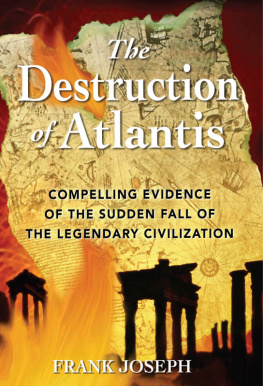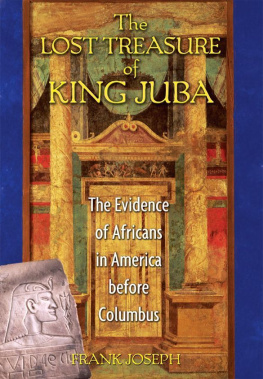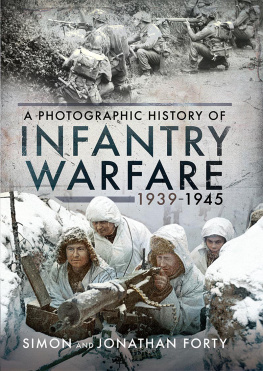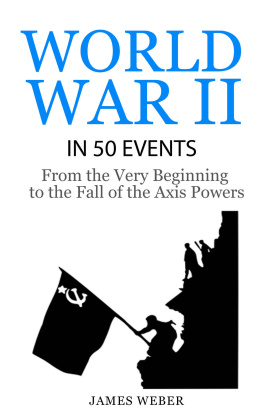All rights reserved. No part of this publication may be reproduced, stored in a retrieval system, or transmitted, in any form or by any means, electronic, mechanical, photocopying, recording, or otherwise, except for the inclusion of brief quotations in a review, without prior permission in writing from the author: Frank Joseph, c/o Ancient American , PO Box 370, Colfax, WI 54730.
Cover art depicts HMS Prince of Wales and HMS Hood in a painting by J.C. Schmitz-Westerholt.
World War Two Turning Points: The Secret Decisions, Censored Blunders, and Forgotten Accidents That Really Determined Its Outcome / Frank Joseph
Includes bibliographical references and index.
The war is not only a great leveler. It is also a great teacher. It makes all rhetoric and slogans obsolete. Judged by its harsh law, only the truest reality will prevail in the end.
Dr. Joseph Goebbels
INTRODUCTION: For Want of a Nail
For want of a nail, the shoe was lost. For want of a shoe, the horse was lost. For want of a horse, the rider was lost. For want of a rider, the message was lost. For want of a message, the battle was lost. For want of a battle, the kingdom was lost. And all for the want of a horseshoe nail.
14th Century English Proverb
Because Turning Points is an alternative investigation of mankinds most controversial conflict, it is itself necessarily contestable. But in the decades following 1945, the Second World Wars most decisive events are still repeatedly assigned to major battles before Moscow and Stalingrad on the Eastern Front, the Normandy Invasion in the West, El Alamein in North Africa, and Midway Island in the Pacific Theater.
The Soviet capital was allegedly saved by a brutal Russian winter that fortuitously paralyzed Hitlers ill-equipped troops, and he was later defeated at the city named after his bolshevik nemesis, due to the dogged resistance of its Red Army defenders. Masses of men and materiel simply overwhelmed all German resistance in France from D-Day onward, after Field Marshal Bernard Montgomery had out-foxed the Afrika Korps in Egypt less than two years earlier. Near Midway Island, U.S. carrier-based dive-bombers dealt the Imperial Japanese Navy a blow from which it never recovered.
While this consensus reality given out to explain Allied victory is correct only in the most fundamental sense, it was so woefully incomplete, as to have been seriously misleading. For example, before Admiral Chichi Nagumos task force got under way to Midway Island, American cryptanalysts had thoroughly broken his military codes. Days prior to the engagement, Admiral Chester Nimitz was provided with the enemys time and place of arrival, complete order of battle, and numerical strength, including numbers and types of aircraft. The intercepts also showed how Nagumo had divided his ships into four, separate task groups too widely separated for mutual support.
By contrast, the Japanese were almost totally unaware of their opponent's true strength and dispositions, even after the battle began. Nimitz had all the information and time necessary to set up an ambush that rendered the Battle of Midway a foregone conclusion.
The crucial role played by his cryptanalysts was not generally acknowledged, however, until many years later, leading 20th Century historians to place too much emphasis on American heroics or Japanese bungling. Both, to be sure, were significant factors in the fleet confrontation, although the actual scale of their contributions to its outcome needs to be understood within the context of code-breaking, which was, after all, the single most important element available to whichever side possessed it.
More disclosures such as this one were going public around the turn of the present Century, as once-classified documents lost their top-secret clearance and aging veterans, whose life-long reputations were intimately bound to their Second World War experiences, passed away. Out of respect for Monty, the ultimate significance of Bletchley Park cryptanalysts at the battle that made him 1st Viscount Montgomery of Alamein was suppressed, even for some years after his death, in 1976.
Especially with the rapid expansion of the Internet, an already vast body of information composed of hitherto obscure, censured and otherwise unknown or forgotten material is growing into an ever-broadening treasure trove of knowledge available to everyone. The wealth of data thus emerging in an irrepressible flood is re-writing the past more radically than any historical revisionist could have previously imagined. Revealed is not only the critical performance of code-breaking in World War Two, but the numerous coincidences or twists of fate, just at the right (or wrong) moment and place, to turn the destiny of an entire global conflagration.
These subtle synchronicities, although mostly overshadowed by the larger events that make it into the textbooks, have been integral components of every war, as indicated by the well-known English proverb --- more than six hundred years old --- quoted above. It summarizes the importance of military logistics throughout the history of human warfare. An important thing to note is that these chains of causality are only seen in hindsight. Nobody ever lamented, upon seeing his unshod horse that the kingdom would eventually fall because of it. Yet, an observation at the core of this adage is a perennial truth that especially applies to and strangely illuminates the neglected, if decisive turning points of our civilizations most profoundly influential conflict.
PART I: Pst! Feind hrt mit! --- "Quiet! The Enemy's Listening!
CHAPTER 1: The Ultra Catastrophe
It was thanks to Ultra that we won the war.
Winston Churchill to King George VI
For three decades after the end of World War Two, mainstream historians believed its foregone conclusion was the result of American industry, British pluck and Russian manpower versus German arrogance, Italian incompetence and Japanese inferiority. This view held sway until the mid-1970s, when the Ultra secret was finally disclosed. It was the code-name for breaking top-secret Axis communiqus by cryptanalysts headquartered at Bletchley Park, an estate located in the town of Bletchley, Buckinghamshire, England.
The object of their exertions was an electro-mechanical cipher machine invented by German engineer Arthur Scherbius, used for the encryption and decryption of classified messages. Near the end of World War One, he offered his design, known as Enigma and patented in February 1918 to the Imperial German Navy and Foreign Office, but officers from both services turned him down.
After the conclusion of hostilities, Scherbius successfully marketed commercial and military copies of Enigma for domestic and foreign customers, eventually constructing approximately one hundred thousand machines for Britain, Italy, Japan, the Netherlands, Poland, Spain, Sweden, Switzerland, and the United States. Many are still in use today by Third World governments.
On 15 July 1928, the Reichswehr, or German Army, as it was known during the postwar Weimar period, introduced its own version, which was the most secure encryption-decryption device in the world at the time, far superior to all others operated by different powers. A combination of mechanical and electrical subsystems, its complexity and cryptographic security resulted from using several rotors --- usually three or four --- in series. The result was a poly-alphabetic substitution cipher effectively resistant to enemy penetration.







![Spencer C. Tucker - World War II [5 Volumes]: The Definitive Encyclopedia and Document Collection](/uploads/posts/book/128138/thumbs/spencer-c-tucker-world-war-ii-5-volumes-the.jpg)
